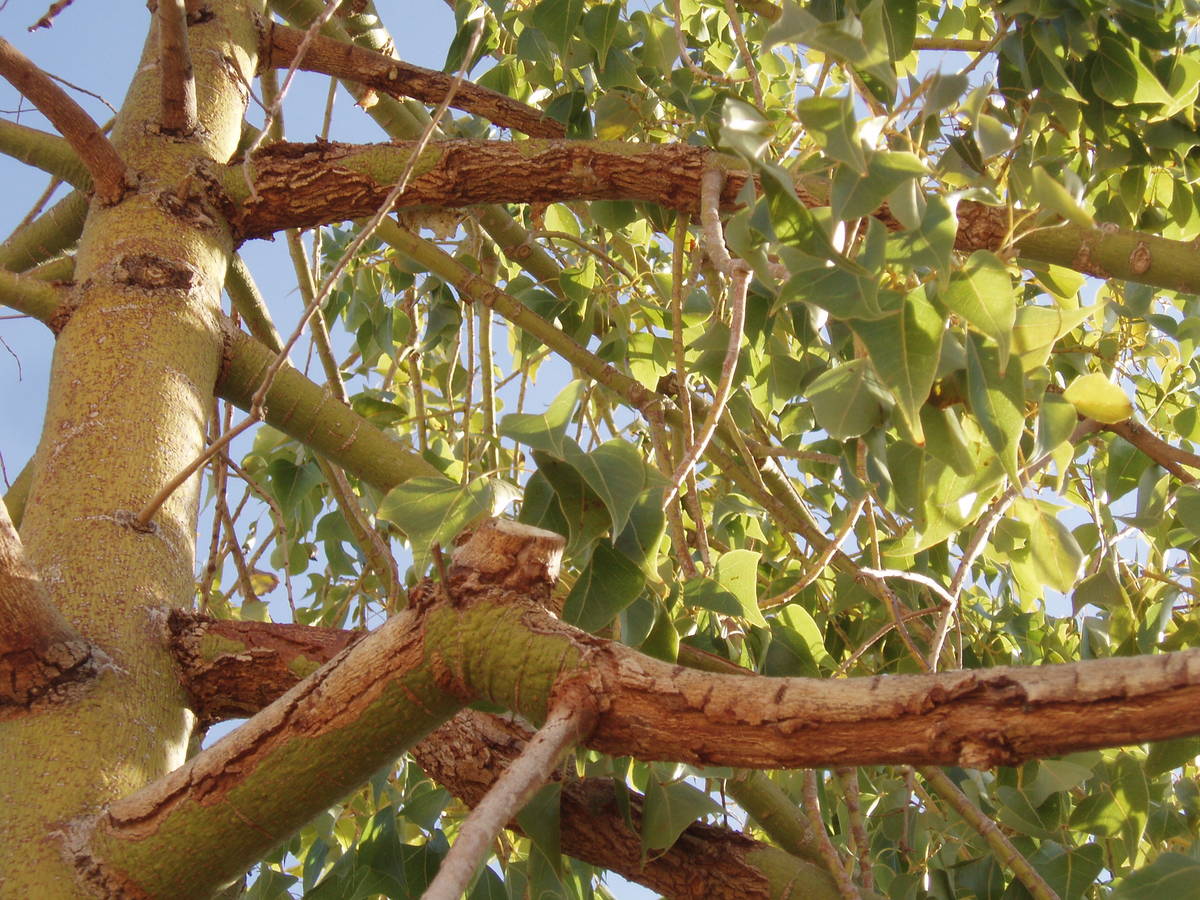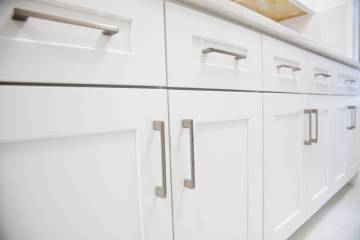True bottle tree different than nursery version
I thought I would talk about bottle trees. The reason for that? I get so many questions about them from readers.
I get more questions from confused readers about this tree than any other landscape tree. These aren’t usually good questions; they are problem questions.
All of these problem questions makes you wonder if they should be planted in our warm desert at all. They should, but choose a good planting location and water them carefully and not haphazardly.
What you are buying from the nursery — Brachychiton populneum — is not really a bottle tree at all. The correct name is kurrajong.
The true bottle tree (B. ruprestis) is very different from the nursery version because its trunk is truly shaped like a bottle. It’s a beautiful oddity in the landscape.
But the true kurrajong hybridizes easily with other types of so-called bottle trees. The growers propagate bottle trees from seed. Seed results from a cross between “mama” and “papa.” Unless the growers are knowledgeable, who knows what you are getting?
The No. 1 question I get is about watering. Bottle trees grow primarily in the dry interior of Australia. They are not a swamp tree, and they are not a cactus but something in between. When you water them, think of them more like watering a palm tree (e.g., date palm) or even asparagus; they like to have their “toes” constantly in water but without the soil around them continuously wet, or they will die.
Leaf drop can be normal. It frequently will drop leaves just before or if it’s not getting enough water, but that does not mean water it more often.
Plant in the spring, not during the hot summer months. Unlike palm trees, they don’t grow well after planting during the heat.
Yes, they should be watered more often after first planting, maybe twice a week in the spring or fall rather than once a week. But after one growing season, apply a lot of water to a large area under its canopy but water less often.
That means either apply the water slowly as in drip irrigation or build a mound or moat around the tree to hold the water so that it sinks in the ground. Applying a lot of water at once uses the same amount because little sips are combined into one big gulp.
The second problem I hear about from readers is sunburn or sun scorch on the tree’s primarily horizontal limbs. Sunburn on the limbs happens for two reasons: The first is because this tree has very thin bark easily sunburned by intense sunlight, and the second reason is because of where it’s planted.
Never plant this tree in the hottest locations. It’s not a mesquite, Cordia or sweet acacia.
Q: I have several bottle trees that have grown well over the last years and one that has always had a slight droop to the branches. I’m not sure what else to do as all the other trees are doing great.
A: If the tree otherwise looks healthy, there may be nothing you can do about it. Growers of bottle trees usually start them from seed. Propagating plants directly from seed creates a lot of tree variability in their growth habit, flower color, seed pod as well as the seed itself.
The result is that some trees are more upright than others, some have different leaf colors, and some are more resistant or susceptible to disease or insects. It’s genetic, and there is nothing much you can do about it.
Other trees propagated from seed include southern live oak and most of our pine trees. So, you see, this variability can be good, or it can be bad if you don’t like its looks or it’s more susceptible to a disease present in your locale.
When trees are young, they oftentimes grow more vertically. They want to get taller and get taller than any competitors nearby.
As they get older, vertical limbs become more horizontal. It’s possible this is what you see.
When it has a full canopy of leaves, then horizontal limbs are not a problem. The dense canopy of leaves shade the thin-barked horizontal branches. But if there is leaf drop from disease, insects, drought or normal leaf drop, then watch for sunburn on these very susceptible limbs.
Because they are native trees, they don’t need a lot of fertilizer. Native plants are like that. They are not commercial hybrids that rely on more soil nutrients applied by fertilizer. That means applying a light application of high nitrogen fertilizer like 16-16-16 or 20-20-20 once a year in the spring just after new growth starts is enough.
Q: Our bottle tree in Scottsdale, Ariz., is 11 years old and this summer had a crazy amount of leaves dropping. So, we watered longer but only once a week. It also gets some water when the lawn is watered, and, right now, that is three times a week. The leaves are very light green, turning brown on the edges first and then completely brown before dropping, leaving it very sparse. Are we not watering long enough, or is it getting too much water?
A: These trees normally drop leaves just before flowering at the beginning of their wet season. In Australia where they are native, that would be just before our fall months.
Many south-of-the-equator trees don’t pay any attention to their new environment and flower or drop their leaves just like they were growing south of the equator. If leaf drop occurred starting around September and got worse a few weeks later, their leaf drop may be a response to longer nights, something totally out of your control.
Your normal summer temperatures — 115 to 120 degrees — are higher than their maximum high temperatures where they grow naturally, 110 degrees. In their environment, the beginning of their monsoon season will mean cooler temperatures.
If there was a significant wind with these high temperatures, then it would mean very hot and dry soil. Your tree may have got hit with a double whammy: high temperatures and intense sunlight.
You did the right thing. You increased the amount of water they received by increasing the amount of water and not the frequency of water application. The only thing I would add is to increase the area where water is applied and not just the amount.
My guess is the tree was getting most of its water (and fertilizer) from the lawn. That’s also probably where most of its roots are growing.
Next time this happens, try watering your lawn a little more often. I think the amount of fertilizer the lawn is getting is plenty for this tree.
Q: We have a true bottle tree (Brachychiton ruprestis, I think) growing in our landscape in Australia that has a very nasty rotten part in the trunk. I was treating it with copper thinking that the problem was some sort of fungus. Unfortunately, the problem is worse, and we are worried we may lose this beautiful tree.
A: Yes, looking at the picture you sent and it’s very characteristic trunk shape, you have the true bottle tree. I suggest buying a copper fungicide called Bordeaux when treating fungal diseases best treated with copper. Fungicides with the appropriate label will tell you how much should be applied and how often.
All trees have a hollow core of dead wood. When a fungus attacks this inner core of dead wood, seldom does this disease attack the living parts of the tree and there is little you can do to stop it.
If the tree otherwise is healthy then it is probably fine. Commonly these types of diseases are saprophytic (attack only dead parts of the tree) but should produce mushrooms called conks that are very distinctive in color and shape.
You can find out how virulent this disease is by identifying the conks. Pictures of conks can be found on Google images by searching conks and trees.
A certified arborist will know how to repair the tree to make it structurally strong. If you choose not to repair it, then it could be damaged during strong winds.
Bob Morris is a horticulture expert and professor emeritus of the University of Nevada, Las Vegas. Visit his blog at xtremehorticulture.blogspot.com. Send questions to Extremehort@aol.com.























